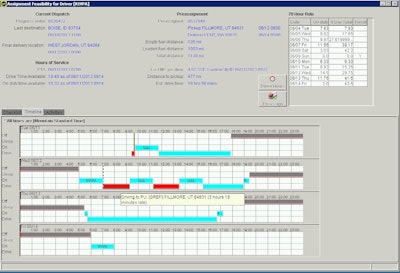Mistakes, even simple ones, can be very costly in this business. Often, by the time they can be caught the damage is already done like a load that is late or an asset that is underutilized and losing money.
 With real-time driver HOS, load planners can make quick decisions. Shown here: McLeod’s LoadMaster’s Driver Feasibility feature.
With real-time driver HOS, load planners can make quick decisions. Shown here: McLeod’s LoadMaster’s Driver Feasibility feature.Even simple decisions may require complex analysis to be certain they are correct. Integrated routing and mobile computing platforms greatly improve the accuracy of data and provide the quick analysis needed to add more stops to a route without running out of available driving hours, to estimate detention time for certain shippers, and much more.
The real-time flow of information between mobile applications and routing software also make it possible to monitor route performance, dynamically dispatch vehicles and give customers more precise information on arrival and departure times, says Pete Allen, chief executive officer of Cadec Global.
Drivers’ hours of service information has become one of the most essential elements in route planning systems to help users quickly find solutions to the many changes that can occur during the workday, says Adam Kahn, director of fleet solutions at OmniTracs.
“We are finding that people are doing more and more data accumulation and consolidation in their planning,” he says. “The ripple effect of making one change starts to change all the other assumptions that you’ve made.”
The impact of fuel performance can also be considered when analyzing and planning routes, even on the fly. Zonar, a provider of electronic fleet inspection, tracking and operations systems, has a unique technology that adds fuel to its GPS reporting. Its GPS sampling density or “breadcrumb trail” increases when fuel consumption increases or “spikes” and relaxes when fuel consumption decreases or is relatively static.
With this level of route activity detail, fleets can easily identify the routes and lanes over which their vehicles are most and least fuel efficient.
A routing platform that combines these types of strategic analysis tools with daily execution can give transportation providers the tools and information they need to gain a competitive advantage in this fast-paced, dynamic industry.













